Campus of the California Institute of Technology
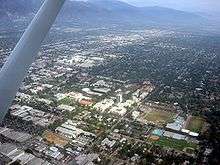
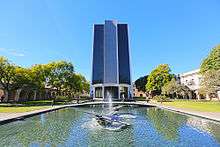
Campus history
Caltech's 124-acre (50 ha) primary campus is located in Pasadena, California, approximately 11 miles (18 km) northeast of downtown Los Angeles. It is within walking distance of Old Town Pasadena and the Pasadena Playhouse District and therefore the two locations are frequent getaways for Caltech students.
In 1917 Hale hired architect Bertram Goodhue to produce a master plan for the 22 acres (8.9 ha) campus. Goodhue conceived the overall layout of the campus and designed the physics building, Dabney Hall, and several other structures, in which he sought to be consistent with the local climate, the character of the school, and Hale's educational philosophy. Goodhue's designs for Caltech were also influenced by the traditional Spanish mission architecture of Southern California.
During the 1960s, Caltech underwent considerable expansion, in part due to the philanthropy of alumnus Arnold O. Beckman. In 1953, Beckman was asked to join the Caltech Board of Trustees.[1]:282 In 1964, he became its chairman.[1]:275 Over the next few years, as Caltech's president emeritus David Baltimore describes it, Arnold Beckman and his wife Mabel "shaped the destiny of Caltech".[1]:288
The Beckmans made a major gift to Caltech in 1962, when they funded the construction of the Beckman Auditorium, a concert hall designed by architect Edward Durrell Stone. When the circular white stone hall opened with a gala concert on February 25, 1964, it was praised for its acoustics.[1]:289–291[2]
The auditorium was the first of several expansions at Caltech that the Beckmans supported. In 1974, the Beckman Laboratory of Behavioral Biology (BBB) was dedicated.[1]:291 The building was seen as a significant step towards the establishment of a new program focusing on neurobiology and a multi-leveled understanding of brain and its mechanisms at the chemical, cellular, and systems levels.[3]:153–154 On April 25, 1986, the Beckman Laboratory of Chemical Synthesis was dedicated. The Beckmans' gift supported not only the building, but also the installation of state-of-the-art scientific instrumentation in six customized laboratories.[4] Finally, the Beckmans funded the Beckman Institute, a multi-disciplinary center for research in the chemical and biological sciences. In 1986, Beckman agreed to donate $50 million towards the institute and its endowment. Designed by architect Albert C. Martin, Jr. in a Spanish style, the Beckman Institute was dedicated on October 26, 1989, and opened in 1990.[1]:275–290
In 1971 a magnitude-6.6 earthquake in San Fernando caused some damage to the Caltech campus. Engineers who evaluated the damage found that two historic buildings dating from the early days of the Institute—Throop Hall and the Goodhue-designed Culbertson Auditorium—had cracked. These were some of the first reinforced concrete buildings, and their plans did not contain enough details (such as how much reinforcing bar had been embedded in the concrete) to be sure they were safe, so the engineers recommended demolition. However, demolishing these historic structures required considerably more effort than would have been necessary had they been in real danger of collapse. A large wrecking ball was used to demolish Throop Hall, and smashing the concrete revealed massive amounts of rebar, far in excess of safety requirements. The rebar had to be cut up before the pieces could be hauled away, and the process took much longer than expected.
New additions to the campus include the Cahill Center for Astronomy and Astrophysics and the Walter and Leonore Annenberg Center for Information Science and Technology, which opened in 2009,[5][6] and the Warren and Katherine Schlinger Laboratory for Chemistry and Chemical Engineering followed in March 2010.[7] The Institute also concluded an upgrading of the south houses in 2006. In late 2010, Caltech completed a 1.3 MW solar array projected to produce approximately 1.6 GWh in 2011.[8]
Notable buildings
Athenaeum
List of buildings
This list includes buildings and facilities of California Institute of Technology.[9] The listing does not include off-campus/co-owned properties.
| Photo | Name | Date competed | Notes |
|---|---|---|---|
 |
Gates and Crellin Laboratories of Chemistry | 1917, 1927, 1937 | The oldest existing building on campus. The 1917 portion of Gates was damaged in the 1971 San Fernando earthquake, and was rebuilt in 1983 as the Parsons-Gates Hall of Administration. Named for C. W. Gates, P. G. Gates, Mr. and Mrs. E. W. Crellin, and Ralph M. Parsons. |
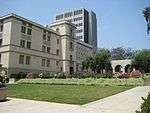 |
Norman Bridge Laboratory of Physics | 1922, 1924, 1925 | Named for Norman Bridge |
 |
Alfred P. Sloan Laboratory of Mathematics and Physics | 1925 | Originally the High Voltage Research Laboratory, which was retired and rebuilt in 1960 into its 1960-2017 configuration. The interior was again stripped entirely and remains under renovation as of 2018. Named for Alfred P. Sloan. |
 |
Dabney Hall | 1928 | Named for Joseph B. Dabney |
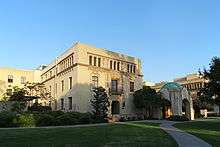 |
William G. Kerckhoff Laboratories of the Biological Sciences | 1928, 1939, 1948 | Named for William G. Kerckhoff |
 |
Guggenheim Aeronautical Laboratory | 1929 | Funded by Daniel Guggenheim Fund for the Promotion of Aeronautics |
 |
Athenaeum | 1930 | The faculty club |
| South Houses | 1931 | Undergraduate houses, including Blacker House, Dabney House, Fleming House, and Ricketts House. Partially renovated in 2006. The Houses are named after Robert R. Blacker, Joseph B. Dabney, Arthur H. Fleming, and L. D. Ricketts. | |
 |
W. K. Kellogg Radiation Laboratory | 1932 | Named for Will Keith Kellogg |
 |
Linde + Robinson Laboratory for Global Environmental Science | 1932 | Formerly Henry M. Robinson Laboratory of Astrophysics, transformed into its current configuration in 2011. Named for Henry M. Robinson and Ronald K. Linde |
 |
Charles Arms Laboratory of the Geological Sciences | 1938 | Named for Charles Arms, father of Mrs. Henry Robinson |
 |
Seeley W. Mudd Laboratory of the Geological Sciences | 1938 | Also known as North Mudd. Named for Seeley W. Mudd. |
 |
Gates–Thomas Laboratory of Engineering | 1945, 1950 | Named for Franklin Thomas and Charles Gates Jr. |
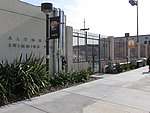 |
Alumni Swimming Pool | 1954 | |
 |
Scott Brown Gymnasium | 1954 | |
 |
Norman W. Church Laboratory for Chemical Biology | 1955 | |
 |
Eudora Hull Spalding Laboratory of Engineering | 1957 | |
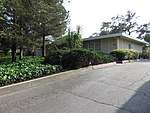 |
Archibald Young Health Center | 1957 | |
 |
Physical Plant Building and Shops | 1959 | |
 |
Gordon A. Alles Laboratory for Molecular Biology | 1960 | Named for Gordon Alles |
 |
North Houses | 1960 | Undergraduate houses, including. Lloyd House, Page House, and Ruddock House |
 |
Harry Chandler Dining Hall | 1960 | Named for Harry Chandler |
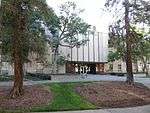 |
W. M. Keck Engineering Laboratories | 1960 | Funded by W. M. Keck Foundation |
 |
Graduate Houses | 1961 | Originally included Braun House, Keck House, Marks House, and Mosher-Jorgensen House. Keck and Mosher-Jorgensen were converted into the Center for Student Services in 2000 and 2002 respectively. Braun and Marks are currently used to house undergraduates. |
 |
Kármán Laboratory of Fluid Mechanics and Jet Propulsion | 1961 | Named for Theodore von Kármán |
 |
Firestone Flight Sciences Laboratory | 1962 | Named for Firestone Tire and Rubber Company |
 |
Winnett Student Center | 1962 | demolished 2017 |
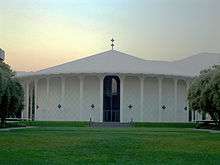 |
Beckman Auditorium | 1964 | Named for Arnold Orville Beckman |
 |
Harry G. Steele Laboratory of Electrical Sciences | 1965 | |
 |
Central Engineering Services Building | 1966 | |
 |
Robert A. Millikan Memorial Library | 1967 | Named for Robert Andrews Millikan |
| Arthur Amos Noyes Laboratory of Chemical Physics | 1967 | Named for Arthur Amos Noyes | |
 |
Central Plant | 1967 | |
 |
George W. Downs Laboratory of Physics and Charles C. Lauritsen Laboratory of High Energy Physics | 1969 | Named for George W. Downs and Charles Christian Lauritsen |
 |
Keith Spalding Building of Business Services | 1969 | |
 |
Donald E. Baxter, M.D., Hall of the Humanities and Social
Sciences |
1971 | Includes Ramo Auditorium, named for Simon Ramo |
 |
The Earle M. Jorgensen Laboratory of Information Science | 1971, 2012 | Complete renovation in 2012; now Jorgensen Laboratory for sustainability research |
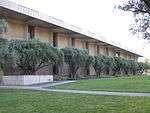 |
The Mabel and Arnold Beckman Laboratories of Behavioral Biology | 1974 | Named for Arnold Orville Beckman |
 |
Seeley G. Mudd Building of Geophysics and Planetary Science | 1974 | Also known as South Mudd. Named for Seeley G. Mudd. |
 |
Clifford S. and Ruth A. Mead Memorial Undergraduate Chemistry Laboratory | 1981 | |
 |
Thomas J. Watson, Sr., Laboratories of Applied Physics | 1982 | Named for Thomas J. Watson |
 |
Braun Laboratories in Memory of Carl F. and Winifred H. Braun | 1982 | |
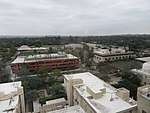 |
Athletic Facility | 1984 | |
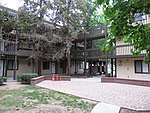 |
Catalina Graduate Apartment Complex | 1984, 1986, 1988 | |
 |
David W. Morrisroe Astroscience Laboratory | 1986 | Originally the Infrared Processing and Analysis Center, renamed in 1995 |
 |
Wilson Avenue North Parking Structure | 1987 | |
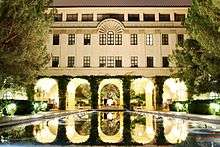 |
Beckman Institute | 1989 | Named for Arnold Orville Beckman |
 |
Braun Athletic Center | 1992 | |
 |
Holliston Avenue Parking Structure/Satellite Utility Plant | 1993 | |
 |
The Gordon and Betty Moore Laboratory of Engineering | 1996 | Named for Gordon Moore and Betty Moore |
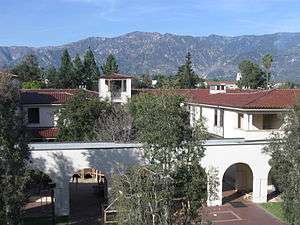 |
Avery House | 1996 | Named for R. Stanton Avery |
 |
Sherman Fairchild Library of Engineering and Applied Science | 1997 | Funded by Sherman Fairchild Foundation |
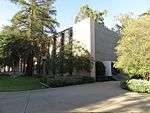 |
Powell-Booth Laboratory for Computational Science | 1963 | Originally the Willis H. Booth Computing Center, renovated in 1999. Named for Willis H. Booth and Charles Lee Powell |
 |
Wilson Avenue South Parking Structure | 1999 | |
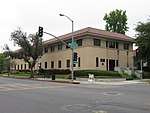 |
Financial Services Building | 2000 | |
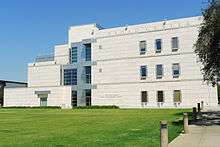 |
Broad Center for the Biological Sciences | 2002 | Named for Eli Broad and Edythe Broad |
 |
California Parking Structure | 2005 | Located underneath the athletic fields |
.jpg) |
Cahill Center for Astronomy and Astrophysics | 2009 | |
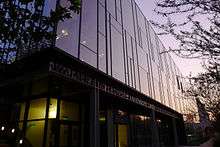 |
Walter and Leonore Annenberg Center for Information Science and Technology | 2009 | Funded by the Annenberg Foundation |
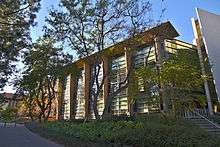 |
Warren and Katharine Schlinger Laboratory for Chemistry and Chemical Engineering | 2010 | |
 |
The Keck Center | 2013 | Incorporates the historic Tolman-Bacher House. Funded by the W. M. Keck Foundation. |
 |
Caltech Childcare Center | 2014 | |
 |
Bechtel Residence | 2018 (planned) | Named for Stephen Bechtel Jr. |
 |
Hameetman Center | 2018 (planned) |
References
- 1 2 3 4 5 6 Arnold Thackray & Minor Myers, Jr. (2000). Arnold O. Beckman : one hundred years of excellence. foreword by James D. Watson. Philadelphia, Pa.: Chemical Heritage Foundation. ISBN 978-0-941901-23-9.
- ↑ "Work begins officially on Caltech Auditorium". The Independent (Pasadena, California). 9 January 1962.
- ↑ Sinsheimer, Robert L. (1994). The strands of a life the science of DNA and the art of education. Berkeley: University of California Press. ISBN 9780520082489. Retrieved 6 April 2017.
- ↑ "Chemical Synthesis: A New Lab Gets it Together" (PDF). Engineering and Science. 49 (5). 1986.
- ↑ "Quantum leap: Caltech facility combines astronomy, astrophysics". AllBusiness. January 26, 2009. Retrieved July 7, 2010.
- ↑ "Walter and Leonore Annenberg Center for Information Science and Technology". Caltech. August 10, 2009. Retrieved July 7, 2010.
- ↑ "Caltech Cuts the Ribbon on Schlinger Laboratory". Caltech. March 9, 2010. Retrieved July 7, 2010.
- ↑ "Perpetual Energy Systems Activates 1.1 MW Solar Energy System at California Institute of Technology". Business Wire. October 21, 2010. Retrieved October 22, 2010.
- ↑ "2012-13 Caltech Catalog" (PDF). California Institute of Technology. September 2012. pp. 19–25. Retrieved 25 September 2012.
External links
| Wikimedia Commons has media related to California Institute of Technology campus. |